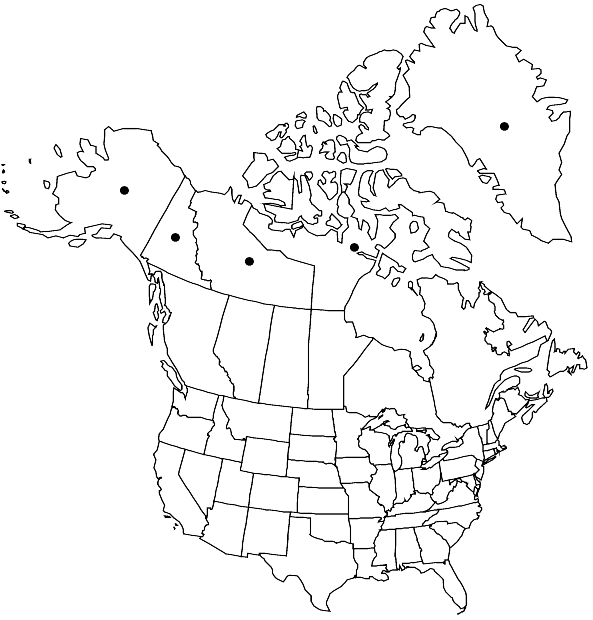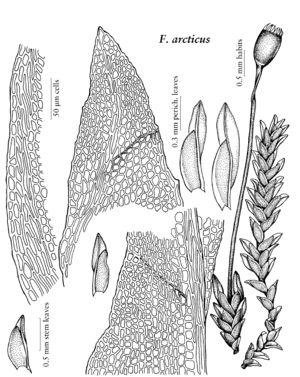Fissidens arcticus
Bryoph. Itin. Pol. Norv., 57, plate 1, fig. 2. 1906,.
Plants to 14 × 3 mm. Stem usually unbranched; axillary hyaline nodules absent; central strand weak. Leaves as many as 40 pairs, lanceolate to oblong-lanceolate, generally broadly acute, 0.4–1.5 × 0.2–0.3 mm; dorsal laminae narrowed proximally, often ending well before insertion; vaginant laminae 1/2–3/4 leaf length, ± equal, minor lamina ending on or near margin; margin entire but often ± serrate distally, limbate on the vaginant laminae, infrequently limbate on dorsal and ventral laminae of perichaetial leaves, limbidial cells 1-stratose; costa usually ending 2–3 cells before apex, bryoides-type; laminal cells 1-stratose, distinct, smooth, slightly bulging, firm-walled, irregularly quadrate to hexagonal, 8–11 µm. Sexual condition polyoicous, most frequently gonioautoicous; naked antheridia often in axils of distal leaves. Sporophytes 1 per perichaetium. Seta 1.75–6 mm. Capsule theca exserted, usually erect, radially symmetric, 0.4–0.8 mm; peristome bryoides-type; operculum 0.6 mm. Calyptra not seen. Spores 14–20 µm.
Habitat: Bare soil in small tufts in wet meadows, silt in frost boils, rock crevices, also as slender strands among tuft-forming bryophytes
Distribution

Greenland, N.W.T., Nunavut, Yukon, Alaska, n Europe
Discussion
Differing opinions have been expressed on the taxonomic standing of Fissidens arcticus. According to W. C. Steere (1978), it might be only an environmentally induced expression of F. bryoides, but A. A. Frisvoll (1981), who reported the species from Svalbard, suggested that it be treated as a subspecies or variety of F. bryoides. They and other previous workers (Steere and G. R. Brassard 1974; M. A. Bruggeman-Nannenga and E. Nyholm 1986), however, did not mention the dimorphic stems, of which the fertile (perichaetial) ones are shorter and have fewer pairs of leaves than the infertile ones. That character and the tendency of the limbidium to be expressed on all laminae of the leaves of perichaetial stems but otherwise restricted to the vaginant lamina of infertile stems distinguish F. arcticus.
Selected References
None.
Lower Taxa
No values specified."/2" is not declared as a valid unit of measurement for this property.
